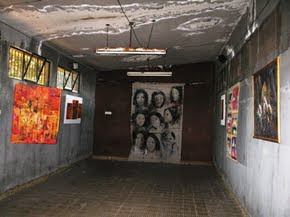Remembrance, Acceptance, and Moving Forward: Chile's History of Torture
By Rebecca West
During Augusto Pinochet's regime, torture was used as the "state policy" to obtain information and create an environment of terror and political prisoners and those who knew them. The most common methods of torture were beatings, suspensions from a ceiling or a wall, electric shock, faked firing squads, and use of human or animal waste as food. 94% of political prisoners were tortured, and 12% were women, almost all of whom experienced sexual violence. 316 of them were raped. Besides psychological damage, people most often experienced impaired vision or hearing, broken teeth, and malfunctioning backs, arms, and legs as a result of the torture.

This hallway was the women's sleeping room at the National Stadium. In such a small space, the women were forced to sleep side by side in rows of two, and their feet would touch in the middle.
Photo source: http://www.globalpost.com/dispatch/chile/090408/remnants-dictatorship
Torture was reported used by both Carabineros (uniformed police) and Investigaciones (plain clothes police) but the Central Nacional de Informaciones (CNI) was most frequently cited for torture. Created in 1977, the CNI would take prisoners to detention centers, such as the one pictured above and below at the National Stadium in Santiago, Chile's capital.
This picture, taken b
 y American-Chilean photographer Cristian Montecino, shows political prisoners being brought into the National Stadium.
y American-Chilean photographer Cristian Montecino, shows political prisoners being brought into the National Stadium.Photo source: http://www.globalpost.com/dispatch/chile/090408/remnants-dictatorship
After the collapse of Pinochet's military regime in 1990, powerful members of society took steps to uncover the truth about the use of torture and its effect on the Chilean people. In 1991, the Archbishop of Santiago established the Archives and Museum of the Vicariate of Solidarity, which contains records of thousands of individuals who were tortured. These records are open to the public and youth especially are encouraged to visit them to learn about their country's past.
Human rights groups in Chile established the Ethics Commission Against Torture, which demanded that the government act to investigate torture as well. They created a nonpartisan commission that would establish a historical record of torture that took place, assess the damage incurred to those tortured, make reparations to the victims and introduce educational material that would help prevent torture in the future. In June 2001, the Chilean government agreed to have Bishop Sergio Valech head this commission, which in turn produced the Valech report on torture.
Published in 2004, the Valech Report claimed that 33,000 Chileans, who had all testified before the commission, had been tortured or severely ill-treated by Chilean police or military. After the Report's publication, President Ricardo Lagos announced that 28,000 of these victims would be offered lifelong pensions as reparations for the mistreatment they had endured.
Today, torture is not seen as much of an issue in Chile, except for some documented instances among police and indigenous peoples. However, the Chilean community is making a great effort to move forward without forgetting their past. The government has been turning detention and torture centers into memorials and museums, establishing them as national monuments to ensure their protection from destruction, alteration, or sale. They have also allocated money for plaques, memorial walls, crosses and sculptures on historically significant sites, as well as renaming streets, health centers, conference halls, parks and schools after victims of torture. There are now 170 memorials and plaques around the country, half of which are in Santiago.
The Chilean government's acknowledgment of the history of torture and their efforts to pay homage to and remember those who were tortured creates an environment of national responsibility that hopefully will help those affected by Pinochet's government to heal, and to help the country of Chile move forward into a promising future.
Sources:
"Amnesty International, Torture in the Eighties, Amnesty International Publications 1984." Remember-Chile. N.p., n.d. Web. 8 Aug. 2010.
Bonnefoy, Pascale. "Remnants of Dictatorship." Chile's torture monuments. Global Post, Apr. 2009. Web. 8 Aug. 2010.
"Chile torture victims win payout." BBC News - World - Americas. BBC News, 29 Nov. 2004. Web. 8 Aug. 2010.
Cleary, Edward. Mobilizing for Human Rights in Latin America. N.p.: Kumarian Press, 2007. 111-27.




